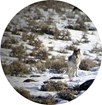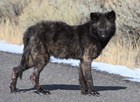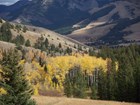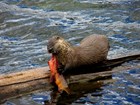Read more about the fascinating 20 years of research that have occurred since wolves were reintroduced to Yellowstone National Park.
-
Yellowstone National Park
Article 1: Lessons Learned from the Yellowstone Wolf Restoration Project

Bruce Babbit, former Secretary of the Interior, writes about his role in wolf reintroduction. Read more
-
Yellowstone National Park
Article 2: Wolf Restoration in Yellowstone: Reintroduction to Recovery

Anthony R.E. Sinclair, long-time researcher in the Serengeti of Africa, suggests that to understand an ecosystem, one also must know its human history. For the Serengeti, he refers to the 1889 outbreak of rinderpest that killed 95% of Africa's cattle and many wild ungulates, and the 19th century ivory trade, both of which drastically altered the plant-animal associations of the 20th century... Read more
-
Yellowstone National Park
Article 3: A Peak Experience Watching Wolves in Yellowstone National Park

After 18 summers of working as a seasonal naturalist in Denali National Park and Glacier National Park, I transferred to Yellowstone in the spring of 1994 and worked as a seasonal naturalist with the title of Wolf Interpreter. All of my programs were on the subject of the upcoming wolf reintroduction. In May 1995, as I was returning to Yellowstone for my second summer, my goal for the season was to see at least one of the newly reintroduced wolves... Read more
-
Yellowstone National Park
Article 4: Infectious Diseases of Wolves in Yellowstone

The summer of 2005 began with such promise for wolves in Yellowstone. The population had been at an all-time high the last few years, and the wolves appeared to be in good condition. Several packs had been particularly busy during the breeding season, and early summer pup counts suggested another healthy crop of new wolves rising through the ranks. And then something changed. Read more
-
Yellowstone National Park
Article 5: Wolf Turf: A Glimpse at 20 Years of Wolf Spatial Ecology in Yellowstone

Territoriality is one of several well-known characteristics of wolf natural history that has presumably evolved in response to selection for behaviors advantageous to individual reproduction and survival. Worldwide, territory characteristics vary depending on ecological conditions (e.g., prey and competitor density), geographical features, seasonal changes, and human presence (Mech and Boitani 2003)... Read more
-
Yellowstone National Park
Article 6: Temporal Variation in Wolf Predation Dynamics

Beginning with the pioneering work of Adolph Murie (1944) in Mount McKinley (now Denali National Park) in 1939-1941, ecologists have long been interested in evaluating the factors influencing wolf predation dynamics. Murie, who had just recently studied coyote ecology in Yellowstone National Park (YNP), was hired to assess wolves’ relationship with Dall sheep. .. Read more
-
Yellowstone National Park
Article 7: The Plight of Aspen: Emerging as a Beneficiary of Wolf Restoration on Yellowstone's Northern Range

Quaking aspen (Populus tremuloides Michx.) is the most widely distributed tree in North America and is native to Yellowstone National Park’s (YNP) northern range, a 250,000 acre area including the valleys of Yellowstone, Lamar, and Gardner rivers. Aspen make up a small component of vegetation on Yellowstone’s landscape, and most stands on the northern range are less than five acres in size... Read more
-
Yellowstone National Park
Article 8: The Big Scientific Debate: Trophic Cascades

Wolves generate controversy. Usually it’s of a cultural kind, like how they should be managed or should we have them at all. Scientific debates tend to take the back seat. Probably the most intense of these is the impact of wolves on their prey because the answer may influence wildlife management. In Yellowstone, a somewhat unique controversy, largely centered within scientific circles, has cropped up and questions how wolves impact ecosystems–if at all... Read more
-
Yellowstone National Park
Article 9: Yellowstone Wolf Facts

Did you know a wolf howl can be heard over 9 miles away in open areas? Learn the facts about Yellowstone's wolves. Read more
-
Yellowstone National Park
Article 10: Five Questions

Three scientists at the forefront of wolf ecology answer the same questions about wolf biology and management. Read more about the interview with L. David Mech, Rolf O. Peterson, & Douglas W. Smith, as interviewed by Charissa Reid. Read more
-
Yellowstone National Park
Article 11: YS 25-1-Shorts
Shorts are articles that summarize the results of recent scientific publications or highlight human interest stories occurring in the GYE. In this issue they discuss Fly Fishing Volunteers, an editorial by Nate Schweber, and birds and mammals that eat cutthroat trout in Yellowstone Lake and its tributaries. Read more
-
Yellowstone National Park
Article 12: The Yellowstone Story

Little did Philetus Norris know that when he picked up Native American artifacts and sent them off to the Smithsonian Institution in the latter half of the 19th century, that he launched what would eventually be a complex and dynamic field of inquiry into the archeology of the world’s first national park. For Yellowstone National Park (YNP), archeology provides a compelling counter narrative to the idea that Yellowstone is a wilderness, untouched by humans... Read more

